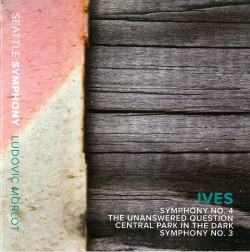 Ives – Symphonies Nos.3 & 4; Unanswered Question; Central Park in the Dark
Ives – Symphonies Nos.3 & 4; Unanswered Question; Central Park in the Dark
Seattle Symphony; Ludovic Morlot
Seattle Symphony SSM1009 (seattlesymphony.org)
Charles Ives had a beautiful musical mind, far ahead of his time. In my youth I watched a televised performance by Stokowski with the American Symphony of Ives’ Symphony No.4 (1910-16). Each subsequent hearing magnifies my appreciation of this masterpiece. Conductor Ludovic Morlot and the Seattle Symphony seem comfortable with the work’s contradictions. Ethereal high strings evoke night uncannily in the short Prelude yet orchestral interruptions are harsh; meanwhile a hopeful chorus sings the hymn Watchman. Is it right to have all of this going on? Ives would say, “Sure – why not?” Then a complex movement, Comedy, goes much further. It opens with quarter-tone string glissandi, the quiet soon intruded on by other material including marches and full brass, sentimental tunes, a piano waltz and a violin solo, often with different simultaneous tempi. Conductor, orchestra and engineer still manage to keep everything in balance in this musical funhouse! The following strict hymn-tune-based Fugue could not contrast more vividly. In the visionary Finale, despite diverse interruptions, Morlot maintains the unifying sense of a parade bookended by percussion-alone passages that emerge from and return to silence.
The classics The Unanswered Question (1908) and Central Park in the Dark (1898-1907) receive scrupulous, loving treatment, with impeccable intonation. In Symphony No. 3, “The Camp Meeting” (1901 - 14) a different side of Ives appears, as turn-of-the-century classical music language combines seamlessly with nineteenth-century American hymnody; this recording presents a persuasive case for the result.



